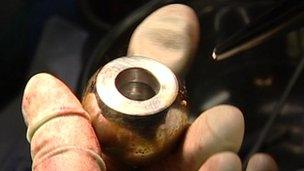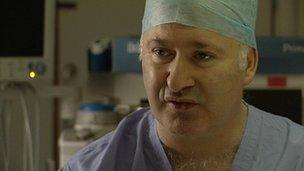MHRA: Metal hip implant patients need life-long checks
- Published
The government's health regulator has advised that patients who have undergone large head metal-on-metal hip replacements should be monitored annually for life.
The new advice comes as a joint BBC Newsnight and British Medical Journal investigation reports that problems with such devices have been long known, but no action taken to block their use.
All-metal hips have a high failure rate and rubbing between the ball and cup can cause metal to break off, seeping into tissue and causing complications.
But despite the fact that the risks posed by these minute pieces of metal have been known and well documented for decades, patients have been kept in the dark.
The Medicines and Healthcare products Regulatory Agency (MHRA) said on Tuesday that around 49,000 UK patients with large-head hip implants out of 65,000 with all-metal hips were in a high-risk category.
The regulator said that they should have blood tests to check for metal ions, and magnetic resonance imaging scans (MRI) if they have raised metal levels or show adverse symptoms.
Dr Susanne Ludgate, Clinical Director of the MHRA, said in a statement:
"Clinical evidence shows that patients have a small risk of suffering complications from having metal-on-metal hip implants...
"As a precautionary measure, we have today issued updated patient management and monitoring advice to surgeons and doctors that they should annually monitor patients for the lifetime of their metal-on-metal total hip replacements that are sized 36 millimetres or more because this particular type of hip replacement has a small risk of causing complications in patients.
This updates previous advice that patients with this type of hip replacement need only be monitored for a minimum of five years after their operation."
Concerns are centred on all-metal hips made of cobalt and chromium. As the parts of the joint rub together and wear, metal debris is generated.
Potentially toxic metals from this debris can cause inflammation, destroying muscle and bone, and enter the bloodstream.
Tony Nargol, a consultant surgeon at the University Hospital of North Tees told Newsnight/BMJ "we are seeing patients with 10, 20, 50 times normal levels. I think our highest level is nearly 300".
Device recalled
One all-metal hip device, manufactured by DePuy, a subsidiary of global health giant Johnson & Johnson, called the ASR was recalled in 2010.
And the company, which is facing legal action from ASR patients, has set aside $3bn in case they have to pay compensation.

Friction from the metal rubbing on metal can cause debris to break off
But Mr Nargol's research suggests there are also problems with an all-metal version of DePuy's Pinnacle hip implant, which is still on sale. The Pinnacle has cups which can be lined with metal, ceramic or plastic.
Mr Nargol's hospital tested the nearly 1,000 patients who had been fitted with the all-metal version of the Pinnacle there.
"The trust has brought back all the patients with Pinnacle cups - nearly 1,000 - tested them all, screened them, scanned them, and we know exactly what's happening," he said. "And we found out that of about 970 patients, 75 failures related to metal debris, which is really quite high."
DePuy told Newsnight and the BMJ that patient safety is their top priority and that clinical data showed that the Pinnacle was safe.
Design change
The Newsnight/BMJ investigation has also found that in a bid to prevent dislocation and increase movement DePuy, like other manufacturers, altered its design of the Pinnacle, making the "head" larger and part of the "stem" shorter.
However, this was done without trials being conducted to demonstrate safety and effectiveness or post-marketing studies to detect any long-term problems and the MHRA was unaware that the design had been changed.
Experts say it is likely that these design changes are responsible for the release of high levels of toxic metals into the body, yet regulators in the US and Europe failed to spot the changes, and despite concerns being raised, failed to warn doctors and patients of the potential dangers.
Mr Nargol said he first told DePuy about damaged tissue in metal-on-metal Pinnacle patients in 2008.
And e-mails, seen by Newsnight/BMJ, show that Japanese surgeons warned DePuy in 2009 that metal debris from the all-metal Pinnacle was harming patients.
In 2010, a senior DePuy executive said in an internal document that he was "concerned" about problems with the metal-on-metal Pinnacle and similar implants. "I feel the problem is emerging as more serious than first thought," he wrote.
The Newsnight/BMJ investigation shows that in the face of mounting evidence of risk from metal-on-metal hips manufacturers remained silent and regulators failed to act.
Internal company documents, seen by Newsnight/BMJ, show that as early as 2005 DePuy was aware of the damage that could be done to patients by metal-on metal-implants.
This included the possibility that they might increase the chances of patients getting some types of cancer:
"In addition to inducing potential changes in immune function, there has been concern for some time that wear debris may be carcinogenic," one memo said.
Regulatory failure
"This isn't the unlucky failure to spot the misdemeanours of one rogue company or the occasional unforeseen breakdown of a small number of devices," BMJ investigations editor Deborah Cohen, who has been working with Newsnight, said of the findings. "It is the inability to prevent a whole class of failing hip implants from being used in hundreds of thousands of people globally."

Surgeon Tony Nargol says the metal-on-metal version of the Pinnacle device has a high failure rate
Carl Heneghan, Director of the Centre for Evidence-Based Medicine in Oxford, says that the fundamental problem is that artificial hips, breast implants, and other devices which are implanted in patients do not have to face the same rigorous tests new drugs do.
He says that whereas drugs have to go through years of clinical trials "you could get a device through with a two or three day literature review and no clinical data requirement at the current time".
And whereas drugs are cleared by a central body, manufacturers of breast or hip implants can choose who they want to approve their new devices. DePuy used the British Standards Institute, known in the UK for applying its "kite mark" to products it has approved.
"This is one very large uncontrolled experiment exposing millions of patients to an unknown risk. We will only find out about the safety of these devices after large numbers of people have already been exposed," says Michael Carome, Deputy Director of Public Citizen's Health Research Group, a US not for profit consumer advocacy group.
- Published28 February 2012